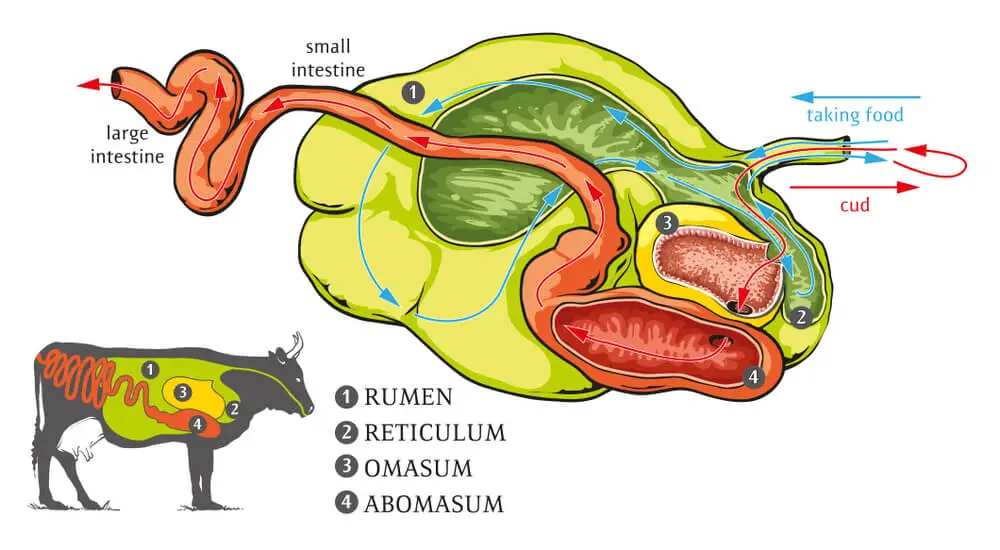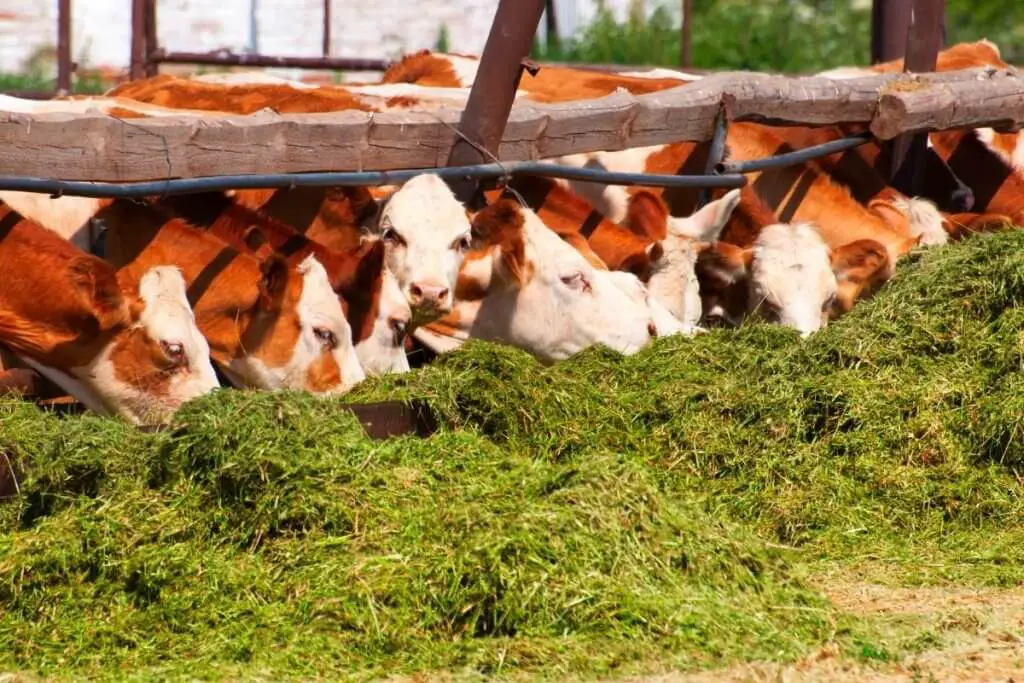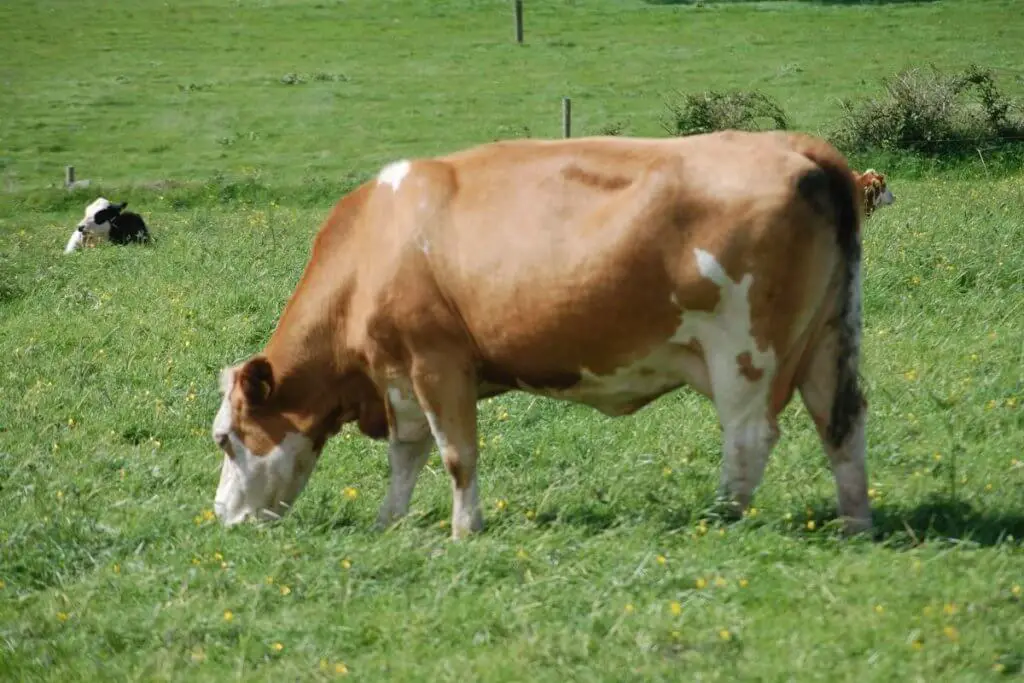Yes, cows and cattle are herbivores. As big plant-eaters, they feast on pasture grasses, hay, dried grass or alfalfa. They’re anatomically and physiologically adapted to eating plant materials as the main component of their diet and always get 100% of the protein they need.
You might be wondering what a herbivore is. This category of the food chain is those who eat only plants.
They’re at quite a low position in the food chain, mostly because they can be hunted and cows eat grass and other plants. They eat quite a range of different plants such as pasture grasses, hay, dried grass or alfalfa. Unlike our friend the carnivore that only eats meat by-products.
You might be wondering how does a huge cow get protein into their diet? Well, they’re anatomically and physiologically adapted to eating plant materials as the main component of their diet. This means the plants they eat will provide and adapt to the enzymes already in the cow to provide them with the protein they need.
Here’s a little explanation below to explain more about what we’ve discussed:
- Most herbivores have mutualistic gut flora which aids the digestion of plant matter.
- Herbivores are the primary consumers in can survive on plant matter alone.
- Cows share the same amino acids as humans do in their rumen stomachs.
The Biology of Dairy Cows
A strange fact about cows is that they don’t eat like you and me. Humans are omnivores. An omnivore is a mammal who eats both plants and proteins. Dairy cows are herbivores as their diet is plant-based only.
They have a digestive system which is called cud it essentially is when a cow will eat something they will not chew it, then later on the food will return back from their digestive system and be later chewed on. I guess you could say that they are always saving their food for later!
The food is held in a part of their stomachs called a rumen, this rumen part is one of the most significant storage compartments in their digestive system. Dairy cows have several digestive tracts.

Dairy cows are just plain and simple ruminants. This means they‘re an even-toed ungulate mammal that chews the cud regurgitated from its rumen. This allows them to be able to store a period for long periods. You could say they could keep food longer than a giraffe‘s neck.
The dairy cows have to eat grass in large quantities to be able to feel fully satisfied. It would take quite a while for them to fill up all 4 of their stomachs. The more that a cow eats the more milk production it will have. This means that if you’re looking to get into milk production then you’ll want to make sure your cows are eating a lot of nutrients.
Cows have canine teeth and 2 molars. The rest are incisors to chew into their food with ease. What herbivores eat, they don’t need strong teeth to properly digest their foods into their digestive tracts.
Dairy cows, are you good for our ecosystem?
This is a topic that has been spoken about a lot in mainstream media. Are these herbivores eating grass that is then converted to methane and potentially causing global warmists have argued the fact for and against the impacts on our ecosystem?
There have been studies to show the effects of cows obtaining mad cow disease (also known as bovine spongiform encephalopathy) by environmental factors too. The factors were that beef cattle were being given the depletion of copper and the high manganese changes in their diets. This was one major factor that changed our animal protein quality and ruined industries for a long while.
Cows are a huge food source for us humans via the meat, dairy and fashion industry, and this over-exerted production of the animal matter is having a huge impact on our ecosystem. The biomass of fields we produce for animal production is at a trophic level.

Studies have shown that the production of 1 single hamburger takes 660 gallons of water, 64.5 square feet of land and over 100 cows. This is a huge impact on our ecosystem as the number of cows that must be produced vs the amount of methane that is produced has an undeniable impact on the ecosystem.
It‘s not all doom and gloom, however herbivorous animals such as the dairy cow can help our ecosystem due to breaking down molecules of the grass and ground to be able to reproduce microbes once again. (the grass dies, and grows back faster). It just shows that without cows we wouldn‘t have half as much grass as we require to have. This is just one of the many secrets to ecology as a whole.
Autotrophs are what cows eat (organisms that create their food). Whereas dairy cows are heterotrophs in the food chain. A nice little balance between autotrophs and heterotrophs is what keeps our ecosystem happy.
These two factors keep the reproduction of plants ongoing and even mammals, this interaction will cause a happy medium called photosynthesis. Now, this is something you may of all learned at kindergarten but – animals such as the dairy cow play an imperative role in the reproduction of plants and food for the beef cattle to eat.
Dairy cows, plant-eaters?
You guessed it right, by now you’ve discovered that dairy cows and beef cattle are nothing but a bunch of big plant-eaters, their milk is used for fermentation to produce cheese and various other dairy products.

Another product that can be utilised from a dairy cow is their carcasses – mostly these are sent off to a sweet factory where they melt the carcasses down and produce gelatine from the remains. Not ideal if you’re a Haribo fan as they have been known to use this method to produce gelatine.
What you may not have known is that these cows have only 2 intestines which are the smaller intestines and the larger ones. If you know anything about human biology, you can tell that we’re not too far away from the cow‘s biology either.
